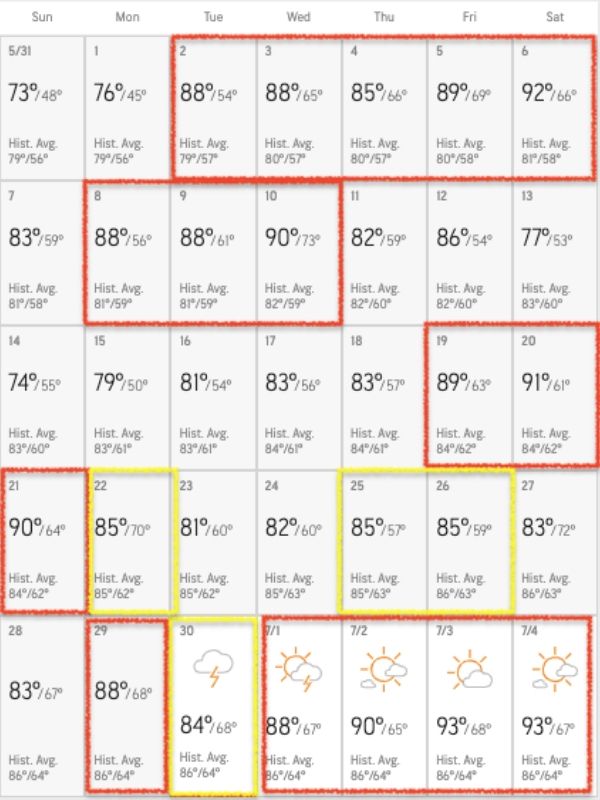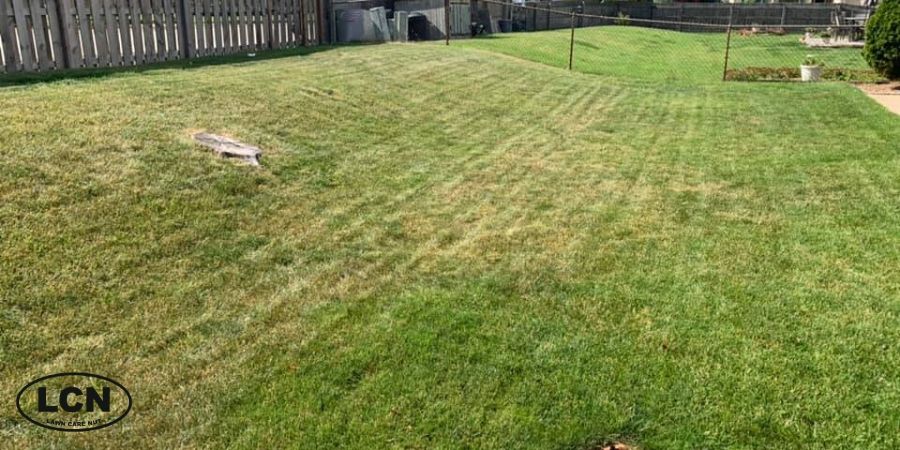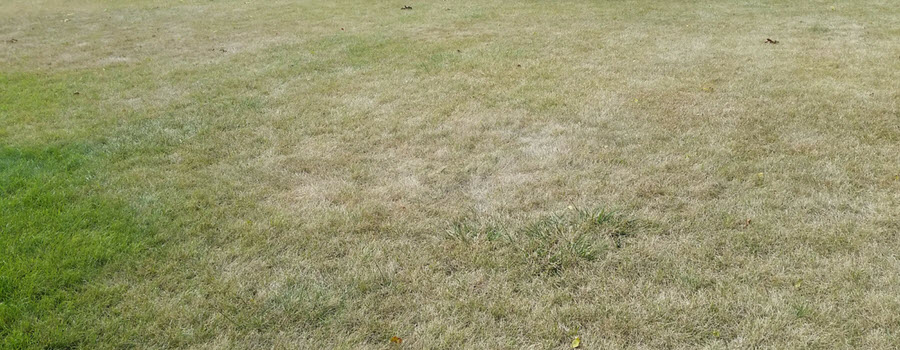Help Your Lawn Manage Summer Weather
- "The Lawn Care Nut"July 4, 2020
It’s hot outside! Pretty much no matter where you live, over this upcoming Independence Day weekend, you are heading for temps in the 90s. That means lawns are going to stress. I am mostly talking to cool season lawns in this one: Kentucky Bluegrass, Perennial Rye and Turf Type Tall Fescue.
For this blog post I am going to use an analogy related to boxing. I want you to think of your lawn like a prize fighter and you are the coach and cornerman. Spring was training camp and now that summer has started just a few weeks ago, we are well into the early rounds of summer with quite a ways to go and your fighter has taken some blows.
Your opponent is the weather.
Let’s see what we are looking at if this fight was taking place in Cincinnati, OH. Look at the early rounds your turf has faced in the last 30 days or so:

The red areas are when your lawn was taking a lot of heavy stress, or “blows” from the summer heat. Cool season turf does not like anything over 85 degrees, but it can handle it ok. However when you get over 90 it’s really stressing and just wants to lay down and give up or, go into summer dormancy.
That’s the key: days that hover at 85 are ok but it’s when you have days mixed in close to 90 that the turf gets stunned.
Now the good news is that in between, you can see it got a little break. This is like the rest between rounds. That rest can really help your turf recover, but as we get into the later rounds, even the best fighter is going to show the damage on his face.
This weather pattern, mostly temperatures, is very similar across a good portion of the transition zone, midwest and east.
This is where you coach, (corner man) come into play. Your fighter needs you, but were you always there?
Chances are that somewhere during these last few weeks you had to work some extra hours and couldn’t be there either during the heavy rounds or during the rest time. Maybe you missed a watering here or there, or maybe coming out of spring, you were not prepared at all and didn’t have your irrigation set up right.
You put all your time and effort into the spring training camp and didn’t plan ahead for the actual fight itself just hoping your fighter would make it through on his own. A couple heavy blows over 90 came in and he got zapped pretty hard. Now you are icing his neck trying to get him to come back because you know there are many round ahead!
Here is what a lawn that has suffered from some of this early round heat stress looks like:

In keeping with this analogy and relating to this picture above: sometimes the corner man is not to blame. In the case of the turf above the part that is stressed the most is on a slope where even the best watering is difficult. On the other hand, it’s not impossible to weather the storm because the lawn in the background does seem to have done better.
And this is just like fighters. Some are known to have a good chin (deep roots) others have excellent cardio (good soil conditions) and some have both. These factors take time to work through.
Either way, let me give you, as your lawn’s corner man, some advice to help you get through summer.
- Learn your land and keep good notes on the weak points. I think some people were spoiled by last year’s mild summer and didn’t know that their lawn even had weaknesses. A good coach takes notes on his fighter during each season so he knows where to focus improvements before the next season.
- Watering is important for sure. I’ve talked often about the Tuna Can Challenge which is where you learn how long your irrigation needs to run (in ground or manual) in order to put down ½” of water. The best watering strategy is one where you water “deep and infrequent” which in summer is getting down ½” of water every 2nd or 3rd day in the morning. In hot and dry spells like we are facing now, I recommend:
- On your scheduled watering days, increase to ¾” of water each cycle. After your cycle finishes, go to your struggling spots and dig out a core and make sure the water is penetrating at least 3” down into the soil. 4” is even better. If that is not happening, take your cycle up to 1”.
- Syringing or day watering can help cool the lawn off on the hottest days. This cycle is purely meant to give the turf some relief and can be done in the middle of the day for 20 minutes or so. Don’t buy into the myth that day watering burns lawns. Here in Florida, it rains every afternoon and we are consistently in the 90s and there are no news stories about mast lawn scorching.
- Mow during the later evening. In many cases, your lawn will still be growing, so you will need to still mow. Mow in the evening as late as your neighbors can stand it. This will provide minimal stress.
- Be careful fertilizing. You really should not apply any type of nitrogen or phosphorus fertilizer to the lawn when you are facing a period of extended days near or over 90. Just wait until things level off in the mid or lower 80s to pick that back up. Think of yourself out working in the heat. You don’t want a steak at that point, just water, maybe a sports drink with vitamins. No steak until you have had time to cool off and recover a little. If you must fertilize, use Milorganite, but if you can wait, wait. Salts in synthetic fertilizers can dehydrate plants, but you don't have to worry about that when it comes to Milorganite. You can apply Milorganite even during the hottest of conditions and it will not burn / stress out the plant. Just apply and wait for the rain to work it into the soil or you can water it in.
From there, keep monitoring your fighter and help get that turf through to the later rounds when we know it will get a “second wind.” The best fighters weather the storm early so they can rebound in the later rounds. Fall is only about 80 days away and I know your fighter can make it.
Plus, maybe our opponent, the weather will give us a break and bring a cold front and some rain.

Last note on this: Summer Dormancy
There is a case to be made for allowing your turf to go into dormancy in summer. This is basically a defense mechanism the turf uses naturally. It does the same thing in winter.
When conditions are not optimal for healthy growth, the turf goes into hibernation so it can live to fight another day. If you have watering restrictions where you live, or your schedule doesn’t allow for the added time to water, just let the turf go into dormancy naturally.
You will still need to give it at least ½” of irrigation or rainfall weekly so the crowns of the grass plant stay alive. Also, if you do decide to let it go dormant, don’t try to bring it out by all of the sudden taking your watering up. Let it stay there until it decides to wake up on its own closer to the fall time.
You will need to prepare for crabgrass though. It doesn’t care anything about heat and summer stress and will rage green in the midst of your brown, dormant lawn.
In the meantime, keep coaching that fighter through the early and middle rounds and hope the weather tires out and gives you (and me) a break.

